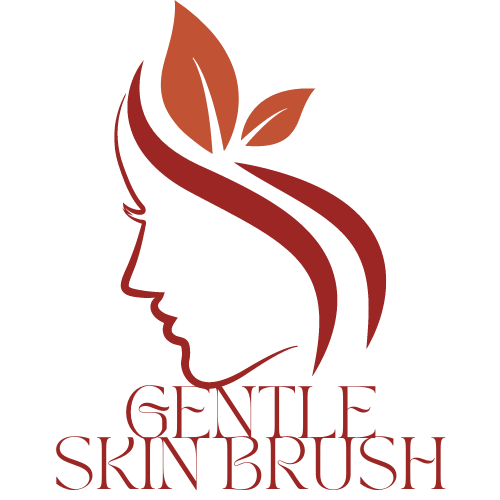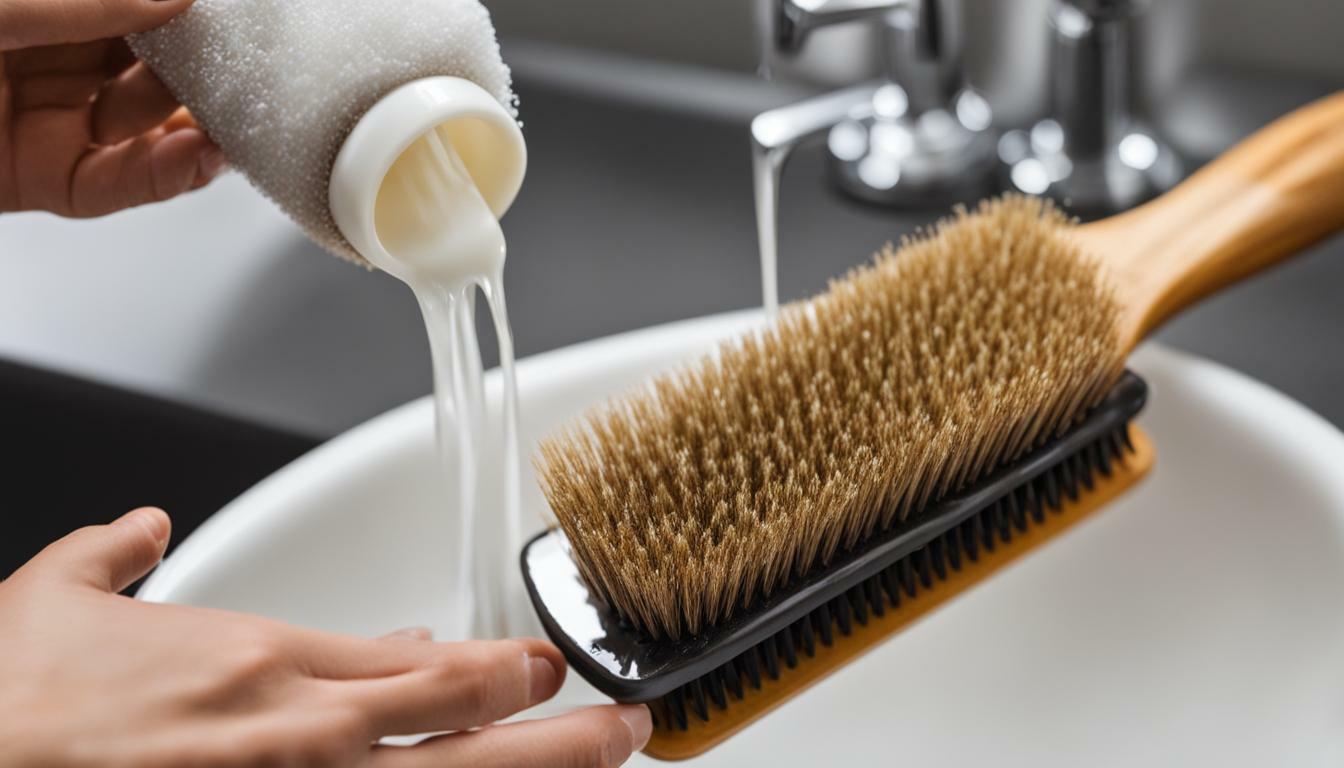Taking care of your hair brush is essential for a tangle-free and healthy hair brushing experience. By following a few simple steps, you can easily soften your hair brush and ensure its longevity. Not only will this give you a more enjoyable brushing experience, but it will also help maintain the softness of your hair.
Contents
Key Takeaways:
- Mix warm water and oil to create a soaking solution for your brush.
- Allow the brush to soak in the mixture for at least five minutes.
- Pat dry the bristles with a paper towel after soaking.
- Use a hair dryer on a medium setting for five minutes to fully dry the brush.
- Repeat the process if the bristles are still hard after drying.
Remember that this method is suitable for brushes with natural bristles and not synthetic ones. If you have an oily scalp, you may skip the oil and soak the brush in warm water only. Avoid using high heat settings on your hair dryer and refrain from using hot water, as they can potentially damage the brush.
Brush Softening Techniques
There are several techniques you can try to soften the bristles of your hair brush and improve its overall performance. Whether you have a natural bristle brush or a synthetic one, these methods can help restore the softness and effectiveness of your brush.
Regular Cleaning: One of the simplest ways to keep your hair brush bristles soft is by regularly cleaning it. Start by removing any hair trapped in the bristles using a comb or your fingers. Then, fill a sink or basin with warm water and a mild shampoo. Swirl the brush around in the soapy water to remove dirt, oil, and product buildup. Rinse the brush thoroughly and pat dry with a towel. Allow it to air dry completely before using it again.
Conditioning Treatment: Just like your hair, your brush can benefit from a conditioning treatment. Apply a small amount of hair conditioner to the bristles and gently massage it in. Leave it on for a few minutes to allow the conditioner to penetrate the bristles. Rinse the brush under warm water to remove the conditioner and pat dry. This will help soften the bristles and leave your brush feeling refreshed.
Hot Water Soak: For brushes with natural bristles, a hot water soak can work wonders. Fill a bowl with hot water and let the brush soak for about 10 minutes. This will help loosen any dirt or product buildup on the bristles. After soaking, gently scrub the bristles with a toothbrush to remove any remaining residue. Rinse the brush under warm water and pat dry. Your brush should feel softer and ready to use!
Table
| Technique | Benefits |
|---|---|
| Regular Cleaning | Removes dirt, oil, and product buildup |
| Conditioning Treatment | Softens bristles and refreshes the brush |
| Hot Water Soak | Loosens buildup and restores softness |
Remember to follow these techniques regularly to maintain the softness of your hair brush. By keeping your brush clean and well-maintained, you’ll ensure it remains effective in detangling and styling your hair. So, give these methods a try and enjoy the benefits of a soft and gentle hair brush!
Proper Brush Cleaning Tips
Regularly cleaning your hair brush is crucial for keeping it in pristine condition and ensuring a healthy scalp. Over time, your brush can accumulate dirt, oil, and product buildup, which can lead to a less effective brushing experience. By following these simple brush cleaning hacks, you can maintain the hygiene of your hair brush and prolong its lifespan.
- Start by removing any hair from the bristles using a comb or your fingers. This will make the cleaning process easier and more effective.
- Fill a sink or basin with warm water and add a few drops of gentle shampoo or liquid soap. Swirl the water to create a soapy solution.
- Place the hair brush in the water, ensuring that the bristles are fully submerged. Gently agitate the brush back and forth to loosen any dirt or residue.
- Use a soft-bristled brush or an old toothbrush to gently scrub the bristles, focusing on any stubborn areas. Be careful not to scrub too vigorously, as this can damage the bristles.
- Rinse the brush thoroughly under running water to remove any soap residue. Make sure to rinse both the bristles and the base of the brush.
- Pat dry the bristles with a clean towel or paper towel. Avoid using a hair dryer, as excessive heat can damage the brush.
- Allow the brush to air dry completely before using it again. You can place it on a clean towel or hang it upside down to ensure proper drying.
Remember, it’s important to clean your hair brush at least once a week, or more frequently if you use a lot of hair products or have an oily scalp. By maintaining a clean brush, you can prevent product buildup, reduce the risk of scalp irritation, and ensure that your brush remains in optimal condition.
Additional Tips for Brush Cleaning
If you’re short on time or don’t have access to water, you can use a dry brush cleaner. These cleaners are typically made of natural fibers and can effectively remove lint, hair, and debris from your brush. Simply run the cleaner through the bristles, following the brush’s pattern, and dispose of the collected residue.
| Do | Don’t |
|---|---|
| Regularly remove hair from the brush to prevent tangling and make cleaning easier. | Submerge the entire brush in water, as this can damage the base and handle. |
| Use a gentle shampoo or liquid soap to clean the brush. | Scrub the bristles too vigorously, as this can damage the brush. |
| Allow the brush to air dry completely before using it again. | Use excessive heat from a hair dryer, as this can warp or melt the bristles. |
By incorporating these brush cleaning tips into your hair care routine, you can keep your brush clean, hygienic, and in optimal condition. This will not only enhance your brushing experience but also contribute to the overall health and appearance of your hair and scalp.
Soaking and Drying Method
The soaking and drying method is an effective way to soften your hair brush and restore its bristles to their original state. Follow these simple steps to achieve a softer brush:
- Mix warm water and a few drops of gentle oil, such as jojoba or almond oil, in a shallow container. The oil helps to condition the bristles and make them more pliable.
- Place the brush in the mixture, bristles down, and let it soak for at least five minutes. This allows the moisture and oil to penetrate the bristles, softening them.
- After soaking, remove the brush from the mixture and pat dry the bristles with a paper towel. Gently press the towel against the bristles to absorb excess moisture.
- Next, use a hair dryer on a medium setting to dry the brush for about five minutes. Hold the hair dryer a few inches away from the brush and move it back and forth to ensure even drying. Avoid using high heat, as it can cause damage to the bristles.
- If the bristles are still hard after the first round of soaking and drying, you can repeat the process to further soften them.
Note that this method is most suitable for brushes with natural bristles, as synthetic bristles may not respond as well to the conditioning properties of oil. Additionally, if you have an oily scalp, you can skip the oil and soak the brush in warm water only. Remember to avoid using hot water, as it can also damage the brush.
By following these steps, you can effectively soften your hair brush and ensure it remains gentle on your hair, providing a comfortable brushing experience.
| Pros | Cons |
|---|---|
| – Simple and affordable method | – Not suitable for brushes with synthetic bristles |
| – Effectively restores bristles to their original state | – Requires time for soaking and drying process |
| – Conditioning properties of oil provide added benefits | – Not recommended for brushes with electronic components |
Conclusion
By following the simple steps and techniques mentioned in this article, you can easily soften your hair brush and ensure a gentle brushing experience for healthier, shinier hair.
To soften a hair brush, start by mixing warm water and oil in a shallow container. Then, place the brush in the mixture with the bristles down and let it soak for at least five minutes. After soaking, pat dry the bristles with a paper towel. To complete the process, use a hair dryer on a medium setting to dry the brush for about five minutes. If the bristles are still hard, repeat the process.
It’s important to note that this method is suitable for brushes with natural bristles, not synthetic ones. If you have an oily scalp, you can skip the oil and soak the brush in warm water only. Additionally, avoid using the hair dryer on high settings or hot water as they can cause damage to the brush.
By taking care of your hair brush and regularly softening its bristles, you can prevent damage to your hair and maintain a healthy brushing routine. Remember to clean your brush regularly to remove dirt, oil, and product buildup, which can contribute to stiff bristles. With these simple tips, you can keep your hair brush in top condition and enjoy the benefits of soft and gentle brushing.
FAQ
How can I soften a hair brush?
To soften a hair brush, you can follow these steps: mix warm water and oil in a shallow container, place the brush in the mixture, bristles down, and let it soak for at least five minutes, pat dry the bristles with a paper towel, use a hair dryer on a medium setting to dry the brush for about five minutes, and repeat the process if the bristles are still hard. Note that this method only works on brushes with natural bristles, not synthetic ones.
What should I do if I have an oily scalp?
If you have an oily scalp, you can skip the oil and soak the brush in warm water only.
Can I use hot water or a high setting on the hair dryer?
No, it is not recommended to use hot water or a high setting on the hair dryer as it can damage the brush.





Leave a Reply